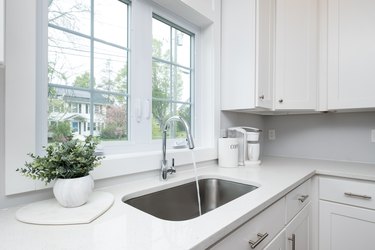
Your water supply should always be safe to drink, but sometimes, things disturb that safety. Flushing water pipes in your home can help clear out potential contaminants and improve the safety of your drinking water. The process is very easy, but it's important to take all steps to ensure the water is as clean as possible after flushing.
Reasons to Flush Water Pipes
Video of the Day
Municipal water should be safe to drink when it comes out of your taps, but water main breaks, water line work, and other issues can send contaminants through the supply line and into your home. It's always a good idea to flush your water pipes if the city replaces water mains, flushes their lines, or does any work on the lines leading to your home. The work can dislodge sediment and send rust, lead, and other potentially dangerous contaminants into your water. Sometimes, you might notice that your water looks discolored or smells funny, and you're not sure why. Flushing the water lines at that time might help clear up the issue.
Video of the Day
Remove and Clean Aerators
Removing your faucet aerators ensures the contaminants don't get stuck in them. It's also a good chance to inspect your faucet aerators to clean them and see if they need to be replaced. The aerator should unscrew off the end of the faucet spout by hand. If it's stuck, use pliers to loosen it. If you plan to reuse the aerator, use a rag between it and the pliers to prevent damage to the finish.
The aerator usually has multiple parts. Disassemble the parts carefully away from the sink to avoid losing parts if you plan to clean and reuse it. Rinse each part and use an old toothbrush if necessary to remove buildup. You can also soak the aerators in vinegar for five to 10 minutes to help remove the buildup.
Set the aerator aside if you plan to reuse it or throw it away if you already have a replacement. Leave the aerators off while you flush the lines.
Flush Hot Water
Start by turning on all the hot water taps in your room, including tubs and sinks. Allow the water to flow from the taps for about 15 minutes. This clears all of the hot water out of your tank water heater and replenishes the existing water with fresh water. You can shut off the hot water taps sooner if you run out of hot water before the 15 minutes have passed.
Alternatively, you can flush your water heater using a garden hose at the heater itself. Shutting off your water heater and letting it cool makes the water easier to work with. You can also run your hot water taps for several minutes to get rid of most of the hot water.
Then, attach a garden hose to the drain valve near the bottom of the water heater tank. Direct the hose outdoors, to a utility sink, to a floor drain, or to another safe drainage area. Shut off the cold water where it goes into the tank, open the drain, and let all of the water empty out of the tank. Turn the cold water on again and let it run while the hose continues to drain until the water is clear and free of sediment. You can now close the drain, remove the hose, and let the water heater refill.
Flush Cold Water
Now, you're ready to flush the cold water lines. Starting on the lowest level of your home, turn on all of the faucets in your sinks and tubs to cold water with full pressure. Let the faucets run for 10 to 20 minutes and ensure the water is clear when you shut them off. Flush all of your toilets a few times while the faucets are running. Turn off the cold water taps from the top floor to the bottom floor.
Flush Your Appliances
Any appliances connected to your water supply should also be flushed. That usually involves running through a cycle or emptying the water and cleaning the system. It's also a good time to change water filters on devices. Some of those appliances include:
- Ice maker: Toss the existing ice and let another round of ice go through. Toss that ice as well and change the water filter on the fridge.
- Dishwasher: Run a full cycle with no dishes in it to flush the dishwasher.
- Washing machine: Run the washing machine through a cycle with no clothes in it.
- Humidifiers and other devices: Empty any devices like humidifiers that use water, clean them, and refill them with fresh water after you've flushed the system.
- Water treatment devices: Flush your water softener and other water treatment devices in your home.